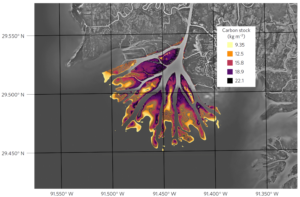NEWS AND EVENTS
Land-building in a river delta can help reduce carbon dioxide emissions
Carbon storage there is larger than previously recognized

LUMCON faculty Alex Kolker is part of a team whose work will be published soon in Nature Geoscience: Carbon storage in the Mississippi River delta enhanced by environmental engineering.
A carbon sink is anywhere on Earth where carbon is stored for an extended period of time. For example, plants use carbon to grow, so a forest is a carbon sink (the carbon will stay in that forest until something changes it, like a fire or logging). Carbon sinks reduce carbon emissions, which contribute to global climate change. Logging our example forest kills the trees and decomposition converts some dead tree material into carbon dioxide gas.
A team of scientists from the University of Florida, the University of Texas at Austin, and LUMCON developed a new technique to measure the carbon storage capacity of the Wax Lake delta in Louisiana, part of the Mississippi River basin.

A computer simulation of carbon storage laid over a map of the Wax Lake Delta, where the team did their research. Figure from Shields et al. 2017.
Traditional storage measurements only count carbon buried in the top meter of sediment, but all the islands in color in the image to the left are new land (naturally built by the river using carbon-containing materials). So the team measured whole-island volumes to estimate carbon burial. They found that carbon storage in the Wax Lake Delta “is comparable to, or greater than, other coastal blue carbon habitats (that is, salt marsh, mangrove, and sea grass meadows)… Furthermore, the land built by this delta, if maintained… should allow for the long-term maintenance of these high rates.”
This is the first time these updated carbon storage measurement methods have ever been used in a modern-day river delta where land is being naturally created. Kolker says that while delta systems historically built new land, “…for the most part, modern deltaic systems around the world are losing land.” This study provides a unique look at what global carbon storage could be like if more natural land-building were occurring in river deltas. The study authors expect that their “…estimates for carbon sequestration that are tied to land building might inform the decisions regarding the strategy of restoration, the location of restoration projects, and the operation of environmental engineering structures such as river diversions.”
You can read more about this study in a University of Florida press release written by lead author Michael Shields.
Featured image by Alex Kolker
